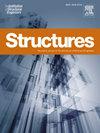Effect of discrete fiber addition on the serviceability performance of glass fiber reinforced polymer concrete beams under flexure
IF 4.3
2区 工程技术
Q1 ENGINEERING, CIVIL
引用次数: 0
Abstract
Glass Fiber Reinforced Polymer (GFRP) rebars are increasingly used in concrete construction due to their excellent mechanical and durability properties. Though GFRP rebars have several advantages, their lower elastic modulus and lack of ductility pose some challenges. Thus, GFRP reinforced concrete (RC) design is usually governed by serviceability. The deflection and crack widths are usually higher in GFRP RC elements. This study explores improving the serviceability performance of the GFRP RC beams by adding discrete fibers. Two types of discrete fibers, namely polyolefin and hybrid (steel + polyolefin) fiber reinforced concrete beams with GFRP rebars are tested in flexure. Further, steel RC beams of equal reinforcement ratio are also tested to compare their serviceability performance with GFRP RC beams. Crack widths and curvatures are measured using the Digital Image Correlation Technique (DIC) technique. Test results show that adding discrete fibers in the GFRP RC significantly improved the serviceability performance. Hybrid fiber addition showed better performance than only Polyolefin fibers. The bond study showed a negligible improvement in bond strength with the addition of discrete fibers. Serviceability recommendations from ACI 440.1 are studied, and an empirical modification is proposed to include the effect of discrete fibers in crack width and deflection estimation.
离散纤维加入对玻璃纤维增强聚合物混凝土梁挠曲使用性能的影响
玻璃纤维增强聚合物(GFRP)钢筋由于其优异的力学性能和耐久性,在混凝土施工中得到越来越多的应用。虽然GFRP筋具有许多优点,但其弹性模量较低,延性不足,给GFRP筋的应用带来了一些挑战。因此,玻璃钢增强混凝土(RC)的设计通常由适用性决定。GFRP混凝土构件的挠度和裂缝宽度通常较高。本研究探讨了通过添加离散纤维来提高GFRP RC梁的使用性能。本文对两种离散纤维——聚烯烃和混杂(钢+聚烯烃)纤维加GFRP筋混凝土梁进行了抗弯试验。此外,还对等配筋率的钢筋混凝土梁与GFRP混凝土梁的使用性能进行了比较试验。采用数字图像相关技术(DIC)测量裂纹宽度和曲率。试验结果表明,在GFRP混凝土中加入离散纤维,可显著提高其使用性能。混杂纤维的添加性能优于单一的聚烯烃纤维。粘结研究表明,加入离散纤维后,粘结强度的改善可以忽略不计。研究了ACI 440.1的适用性建议,并提出了一个经验修正,以包括裂缝宽度和挠度估计中离散纤维的影响。
本文章由计算机程序翻译,如有差异,请以英文原文为准。
求助全文
约1分钟内获得全文
求助全文
来源期刊

Structures
Engineering-Architecture
CiteScore
5.70
自引率
17.10%
发文量
1187
期刊介绍:
Structures aims to publish internationally-leading research across the full breadth of structural engineering. Papers for Structures are particularly welcome in which high-quality research will benefit from wide readership of academics and practitioners such that not only high citation rates but also tangible industrial-related pathways to impact are achieved.
 求助内容:
求助内容: 应助结果提醒方式:
应助结果提醒方式:


